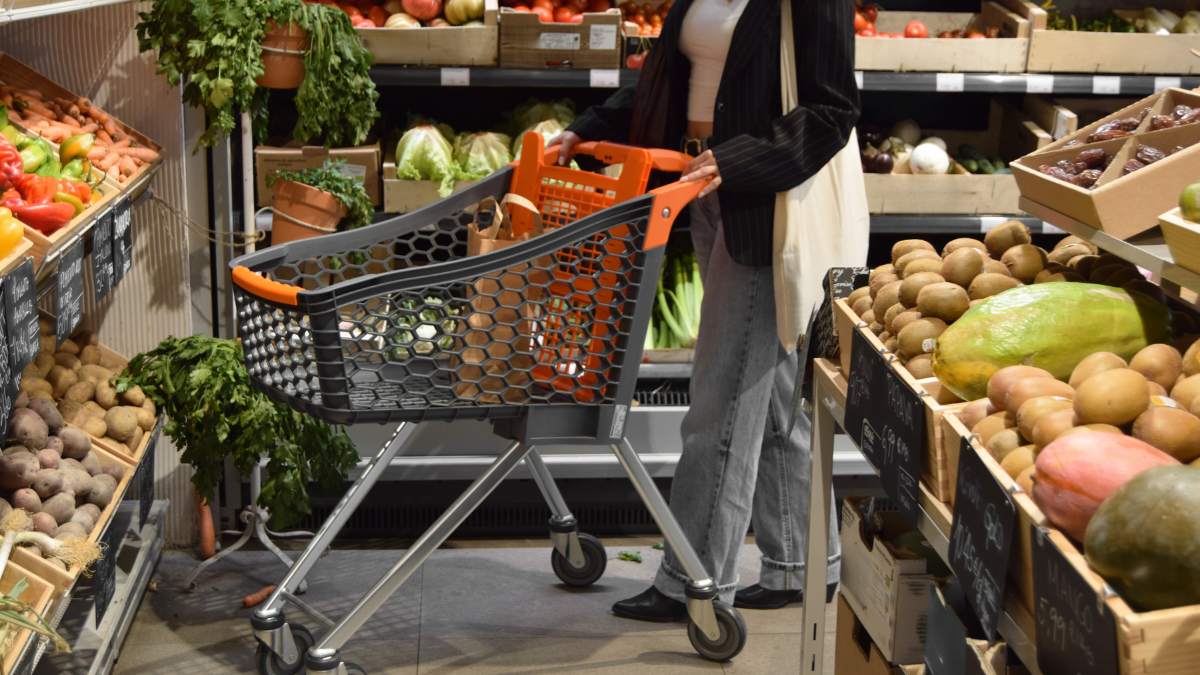$100 Weekly Grocery Budget: Meal Plan + Free Spreadsheet

Groceries getting expensive? You’re not alone. Every trip to the store seems to cost more than the last—and before you know it, your “quick shopping run” has eaten up half your weekly budget.
But here’s the good news: you can eat well, save money, and keep things simple. All it takes is a little planning.
In this post, I’ll walk you through a $100 weekly meal plan that’s realistic, family-friendly, and easy to stick with.
We’ll also cover a grocery list of affordable staples, plus you’ll get a free spreadsheet to track your spending (so you know exactly where every dollar is going).
Think of it as your stress-free guide to feeding yourself or your family—without blowing your budget.
In this post, I’ll share:
- A realistic $100 weekly meal plan
- Smart budget grocery shopping tips
- A free printable + editable spreadsheet to track your spending
If you’ve been wanting to save money without feeling deprived, this guide is for you.
🛒 Why a $100 Weekly Grocery Budget Works
Whether you’re feeding yourself or a small family, $100 is a manageable and realistic target. It forces you to:
- Plan meals in advance
- Avoid impulse buys
- Waste less food
- Stretch ingredients creatively
Think of it as a weekly challenge that helps you build smarter money habits—while keeping your fridge stocked.
🧮 Free $100 Weekly Grocery Budget Spreadsheet
To make this easier, I created a free printable + editable spreadsheet you can use to:
- Track weekly spending
- Categorize groceries (produce, protein, pantry, snacks)
- Plan meals side by side with your budget
- Stay on track without guessing
👉 Download your free $100 Grocery Budget Spreadsheet here
(Pro tip: Offer this as a lead magnet to grow your email list!)
📋 $100 Weekly Meal Plan
Here’s a 7-day meal plan designed to keep your grocery budget around $100. It’s built on affordable staples like rice, beans, eggs, pasta, chicken, and frozen veggies—foods that stretch well across multiple recipes. By reusing ingredients in different ways, you’ll save money and reduce food waste.
🍳 Breakfasts (approx. $20 for the week)
Breakfast doesn’t need to be fancy to be filling. These options are quick, healthy, and cost-effective:
- Oatmeal with banana + peanut butter
- Oats are one of the cheapest staples and keep you full. Add sliced bananas and a spoonful of peanut butter for protein and flavor.
- Oats are one of the cheapest staples and keep you full. Add sliced bananas and a spoonful of peanut butter for protein and flavor.
- Scrambled eggs with toast
- Eggs are versatile and budget-friendly. Pair with toast (store-brand bread) for a complete meal.
- Eggs are versatile and budget-friendly. Pair with toast (store-brand bread) for a complete meal.
- Yogurt with frozen berries
- Buy a large tub of plain yogurt and sweeten it yourself with frozen berries instead of pre-flavored cups.
- Buy a large tub of plain yogurt and sweeten it yourself with frozen berries instead of pre-flavored cups.
- Smoothie (spinach, banana, protein powder if available)
- Frozen spinach and bananas are inexpensive smoothie bases. Add protein powder if you already have it, or just stick to fruit + greens.
- Frozen spinach and bananas are inexpensive smoothie bases. Add protein powder if you already have it, or just stick to fruit + greens.
- Homemade breakfast burrito (eggs, beans, salsa)
- Wrap scrambled eggs, beans, and salsa in a tortilla. These can also be prepped in bulk and frozen for busy mornings.
💡 Tip: Rotate these throughout the week so you never get bored.
🥪 Lunches (approx. $25 for the week)
Lunches are designed to be quick and use up dinner leftovers when possible.
- Turkey or chicken sandwiches with carrot sticks
- Deli meat (buy in bulk or use leftover cooked chicken) + cheese + veggies = affordable, filling meal.
- Deli meat (buy in bulk or use leftover cooked chicken) + cheese + veggies = affordable, filling meal.
- Leftovers from dinner
- Cook once, eat twice. Plan to intentionally make extra at dinner for easy lunches.
- Cook once, eat twice. Plan to intentionally make extra at dinner for easy lunches.
- Tuna salad with crackers
- Canned tuna mixed with mayo or Greek yogurt. Serve with crackers or bread.
- Canned tuna mixed with mayo or Greek yogurt. Serve with crackers or bread.
- Egg salad wraps
- Hard-boil eggs, mix with mayo and seasonings, wrap in tortillas. Cheap and protein-packed.
- Hard-boil eggs, mix with mayo and seasonings, wrap in tortillas. Cheap and protein-packed.
- Rice + beans with salsa + avocado
- Classic budget-friendly lunch. A squeeze of lime or sprinkle of cheese takes it up a notch.
💡 Tip: Prep 2–3 lunches ahead of time so you avoid eating out during the week.
🍲 Dinners (approx. $45 for the week)
Dinners are where most of your budget goes, but they’re still simple, filling, and affordable.
- Monday: Spaghetti with marinara + side salad
Affordable pasta, jarred marinara, and a bag of salad mix = dinner under $6. - Tuesday: Chicken stir-fry with rice and veggies
Use chicken thighs (cheaper than breasts), frozen stir-fry veggies, and soy sauce. - Wednesday: Bean + veggie chili with cornbread
Canned beans + tomatoes + spices = hearty and cheap. Cornbread mix is usually $1–2. - Thursday: Tacos with ground turkey, beans, and toppings
Stretch ground turkey by mixing it with black beans. Add tortillas, salsa, and lettuce. - Friday: Baked chicken thighs + roasted potatoes + green beans
Sheet pan dinners are budget-friendly, filling, and require minimal cleanup. - Saturday: Homemade pizza night (using tortillas or dough)
Use tortillas or homemade dough with marinara, cheese, and any leftover veggies. - Sunday: Slow cooker soup with bread
Use leftover veggies, beans, or chicken. Serve with bread for a hearty end-of-week meal.
💡 Tip: Double recipes like chili or soup to freeze for future weeks.
🍎 Snacks (approx. $10 for the week)
Snacks keep you satisfied between meals without breaking the bank:
- Popcorn (buy kernels instead of pre-popped)
- Apples + peanut butter
- Cheese sticks (buy in bulk packs)
- Homemade granola bars (oats, honey, peanut butter)
💡 Tip: Avoid single-serve snack packs—they cost more for less food.
🛒 Grocery List for $100 Budget
Here’s a core shopping list to make this meal plan work (prices will vary by region):
Proteins:
- Chicken thighs
- Ground turkey
- Canned tuna
- Eggs
Grains:
- Rice
- Pasta
- Oats
- Tortillas
- Bread
Beans/Legumes:
- Black beans
- Pinto beans
- Lentils
Veggies:
- Frozen mixed veggies
- Carrots
- Spinach
- Potatoes
- Onions
- Bell peppers
Fruits:
- Bananas
- Apples
- Frozen berries
Dairy:
- Milk
- Yogurt
- Cheese
Pantry Staples:
- Peanut butter
- Salsa
- Marinara sauce
- Spices (garlic, chili powder, cumin, etc.)
- Cooking oil
💡 Tip: Check weekly store flyers and swap proteins/produce based on what’s on sale.
✅ With this plan, you’ll stretch every dollar, avoid food waste, and still eat a variety of tasty, filling meals.
🛍 Tips to Stick to Your $100 Weekly Grocery Budget
- Shop your pantry first – Plan meals around what you already have.
- Buy generic/store brand – Quality is often the same, cost is less.
- Use freezer staples – Frozen fruits & veggies save money and reduce waste.
- Plan 1–2 meatless meals per week – Beans and lentils are budget-friendly.
- Cook once, eat twice – Double recipes and enjoy leftovers for lunch.
- Make a list and stick to it – Impulse buys add up quickly.
- Shop sales and use apps – Check store flyers and rebate apps like Ibotta.
📈 Why Tracking Your Grocery Spending Matters
Budgeting isn’t just about cutting costs—it’s about awareness and control. Once you start tracking your grocery spending, you’ll notice patterns:
- Which meals cost less but keep everyone full
- Which items you’re overspending on
- How meal planning reduces waste
Your spreadsheet will help you stay accountable week after week.
✨ Final Thoughts
Sticking to a $100 grocery budget might feel intimidating at first, but once you try it, you’ll see how doable it really is. A little planning, some smart shopping, and a willingness to reuse ingredients in creative ways can make a big difference.
The best part? Saving on groceries doesn’t mean eating boring meals. From tacos and stir-fry to chili and homemade pizza, you’ll still enjoy food that feels good—without the guilt of overspending.
So here’s your challenge: try this week’s plan, grab your free grocery budget spreadsheet, and see how much you can save. You might be surprised at how quickly the extra money adds up—money you can put toward savings, paying off debt, or even a fun treat.
You’ve got this—your wallet (and your dinner table) will thank you.

